Email Marketing Analytics: How to Measure and Track the Most Important Metrics
Do you know how well your email marketing campaign is performing?
There are several important metrics that you should be measuring and regularly tracking if you want to maintain email list health and improve your ROI (return on investment).
Understanding email marketing analytics is the first step to optimizing your campaigns. So, in this guide, you will learn:
Why do you need to measure and track email marketing campaigns?
Without measuring and tracking emails, you can’t total up your email marketing efforts. Consequently, you’ll have a blur and inaccurate image of how well things work for you.
Email marketing analytics provide a vast amount of data as a basis for improvements, such as:
- Common behavior patterns
- The level of user engagement and loyalty
- Strong and weak points of your content
With that knowledge in mind, you can utilize sophisticated behavioral segmentation and provide your subscribers with a much more personalized experience.
As a result, email marketing analytics help your business prosper, as users will be more engaged with your brand, hence more likely to buy your products or services.
5 steps to create a measurement plan
1. Choose your timing
You should track your email performance on an ongoing basis. However, before setting KPIs, it is a good idea to establish a tracking schedule - whether it’s daily, weekly, monthly, or campaign by campaign.
At any rate, you can check your progress against benchmarks and previous performance, which makes it simple to spot patterns of improvement or decline (we’ll talk about this later!).
These can then be marked against a particular type of email marketing campaign, a customer segment, product type, or external factors that could impact the campaign’s performance.
2. Outline your campaign goals and objectives
Performance measurement and tracking should be relevant to your campaign goals and objectives.

At the early stage of strategizing, it’s essential to establish clear goals and objectives. While defining these, think hard about how measurable they are and how that measuring can be implemented.
3. Benchmark your performance
Looking at different markets, products, and email lists can’t help you decide how you are doing. You need to look closer to home, in your own industry.
As a matter of fact, there are 2 resources to help your benchmark your performance:
#1. Keeping an eye on your peers
The first resource is other people in your own industry.
If you’re a beauty brand, knowing how email marketing performs for other businesses offering beauty services will give you a good benchmark of what success should look like.
How can you find these answers?
Fortunately, MailChimp has created the best resource ever to take a peek into your peers’ email marketing metrics. This resource includes averaged email performance data for 46 different industries, ranging from Agriculture and Food Services all the way to Vitamin Supplements.
Because MailChimp sends more than 10 billion emails per month, the information is extremely representative of behavior patterns.
Below is a look at some of that email marketing data:
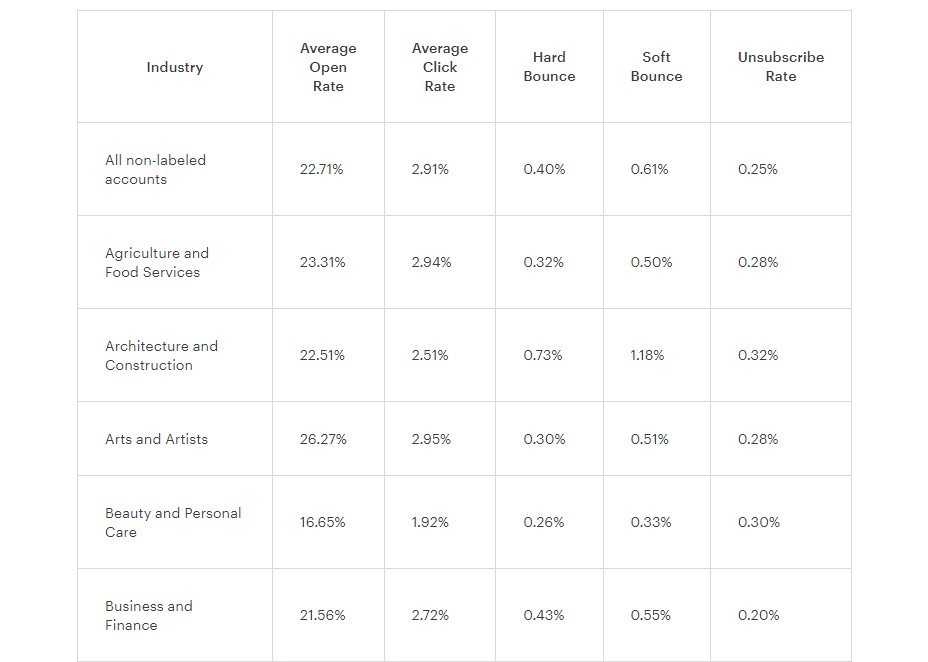
#2. Looking to the past
Looking at past performance is another excellent way to get a sense of where your campaign is at the moment.
To turn your historical data into something useful, you need to compile it.
This can be done pretty easily by generating averages for your metrics based on the past:
- 6 months
- Year
- 3 years
Whether or not your email campaign is where you want it to be today, you should understand clearly where you are right now. By leveraging these two different sets of data, you can get reasonable expectations and understand how your email marketing shapes up.
4. See what’s working (and what’s not)
Data analytics can shed light on the most engaging by analyzing the links or imagery that have driven the most clicks.
Also, by analyzing your audience’s behavior, you can learn more about them, such as what interests them or which content is effective in driving any action or engagement.
5. Improve
It’s important to realize your problems and improve them.
You will need to be patient. Big changes, especially in email marketing, take time. Be patient and set reasonable timelines, and just don’t expect miracles after two campaign sends.
Email marketing is a complicated system, and it depends on more than just your performance. There are many external factors at play, requiring you to work and test towards finding what really works for you.
7 essential email marketing metrics to measure
Before you send a campaign and start measuring, you should understand the following essential metrics.
1. Open rate
Your open rate refers to the percentage of recipients that opened your email. This is a critical metric because your email marketing campaigns won’t do a thing unless recipients are actually opening and reading them.

However, marketers should remember that an email is considered “opened” only when the subscriber receives the images included therein. That means if your email users have enabled image-blocking on their email client, they won’t be counted in the open rate. Consequently, the result you receive might be somewhat unreliable.
In spite of this, it’s a valuable metric if you use it as a comparative metric. We mean to say that if you compare your open rate of the email sent last week and this week, it’ll throw light on how receptive your subscribers are to your emails.
2. Click-through rate (CTR)
Your click-through rate (CTR) refers to the percentage of recipients that clicked on a link inside your email.

Most of the time, getting your subscribers to click on a link inside the email is the primary goal of your campaign, so this is an essential metric to measure. Your CTR is directly proportional to the number of people that are interested in hearing from you. The higher, the better!
Read more: How to Improve Email Click-through Rate?
3. Conversion rate
Your conversion rate is the percentage of recipients that completed your desired action (e.g., buying a product).
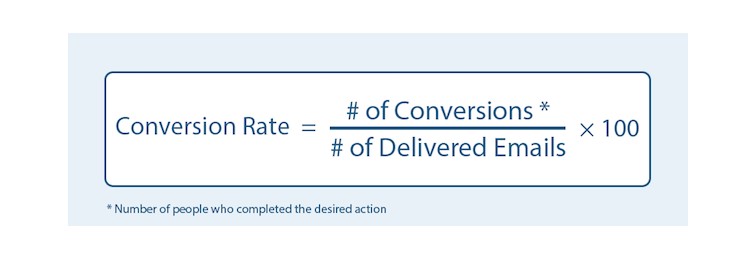
There are many factors affecting your conversion rate, depending on what a successful conversion is in your specific campaign. If a conversion is a successful action happening on your website after someone clicks on a link inside your email, you will want to ensure that your website is optimized for conversions.
4. List growth rate
Your list growth rate refers to the rate at which your email list has grown over a particular period of time.
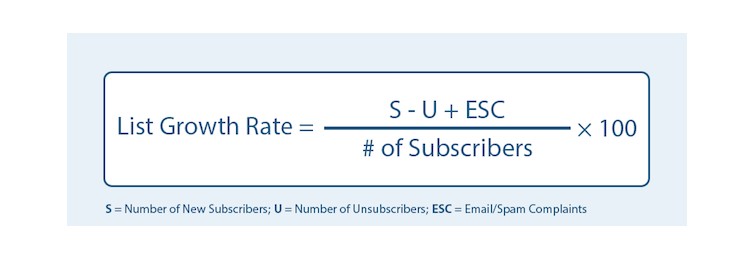
If your list isn’t growing, it is actually dying. Now only do people unsubscribe, but email addresses also tend to go “bad” over time due to people switching their email accounts and abandoning the old one. Ensure you’re constantly building your list and keeping your unsubscribes at a reasonable rate.
5. Email forwarding/ sharing rate
Your email forwarding/ sharing rate is the percent of recipients who forwarded your email to their friends or shared your email by clicking on a share button right inside your email.
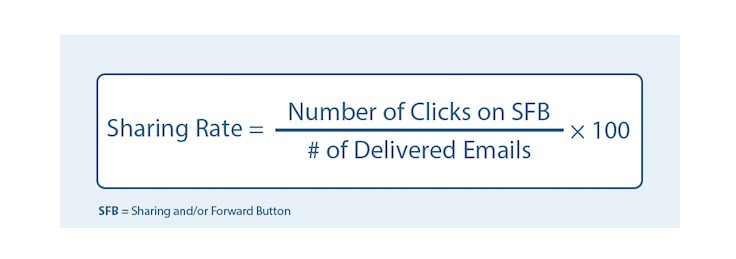
This may not seem like an essential metric to measure, but it’s a really good thing to try and increase. If your recipients are forwarding your emails, that means they’re actually becoming ambassadors of your brand and generating new leads for you.
6. Bounce rate
Your bounce rate is the percentage of emails that fail to land in the recipient’s inbox.

A low bounce rate often contributes to a good sender reputation. On the other hand, a high bounce rate means that your content is going undelivered (and unseen), which eventually lowers your sender reputation.
There are two types of bounces - a hard bounce or a soft bounce. A hard bounce happens when the email couldn’t be delivered for a permanent reason (e.g., the email address doesn’t exist). A soft bounce indicates a temporary reason (e.g., an inbox is full).
7. Unsubscribe rate
Your unsubscribe rate is the percentage of recipients who clicked on the “Unsubscribe” link inside your email.

Unsubscribes represent the number of recipients who are no longer interested in hearing from you. While it’s an unfortunate event itself, unsubscribes are good for your email list health as it helps get rid of disengaged subscribers.
For more information on each metric, you should read our blog named Top 11 Most Essential Email Marketing KPIs & Metrics to Track.
7 ways to optimize your email marketing metrics
1. Boost your open rate by writing engaging subject lines
Your subject line is the first thing that subscribers see in order to open your email. Thus, it must pique their interest and make them curious about what is inside.
Personalizing your email subject lines can make the recipient feel special and increase the likelihood of your emails getting opened.
Let’s look at this email from Saks Fifth Avenue.
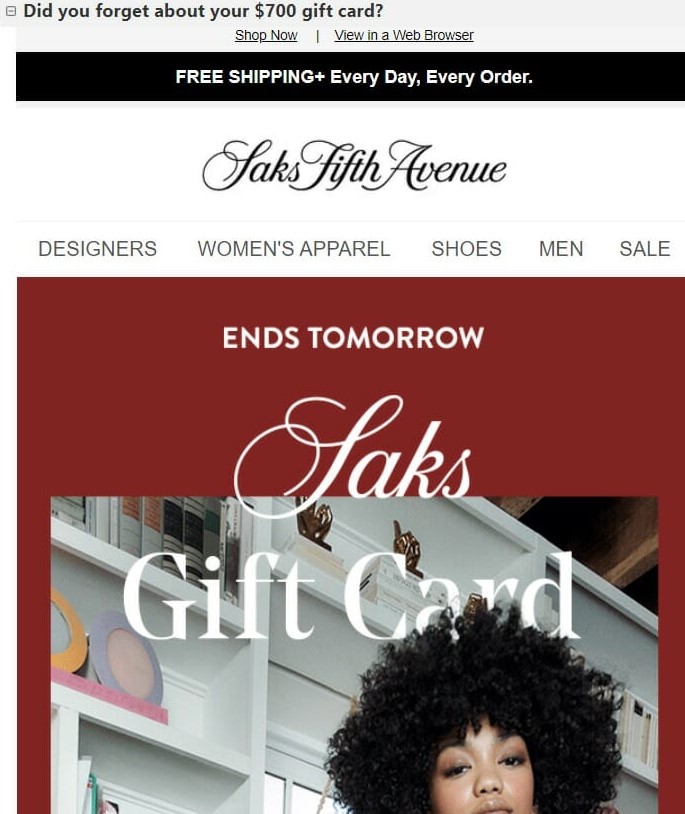
The subject line “Did you forget about your $700 gift card?” is sure to immediately grab subscribers’ attention and entice them to open the email.
Related topics:
- How to Write Best Subject Lines for Open Rates?
- The Guide for Email Subject Line Testing
- 99+ Best Abandoned Cart Email Subject Lines
2. Improve your CTR by sending relevant content with powerful CTAs
CTR is related to the value you provide through your emails. You must deliver tailor-made content that addresses the challenges of your subscribers and motivates them to click on the CTA (call-to-action) button.
Your CTA is an integral part of any email and it works as the powerhouse of conversions. Therefore, you must ensure to draft actionable CTAs that compel the user to take the next action.

Besides, A/B test your email layout, CTA design, as well as its placement to determine what drives maximum people to click through.
3. Optimize the list growth rate by building short sign-up forms
To drive business growth, you must be able to create a steady flow of leads and build an extensive email list with qualified prospects.
This is possible only if you have short sign-up forms and interesting landing pages. If visitors click on your PPC ad, they must be redirected to a landing page that lets them know more about your product/ service, so that they can fill out the form or convert.
4. Boost the email forwarding rate by making emails visually appealing
Your subscribers are more likely to share and forward your email if it has something unique.
To boost the email forwarding rate, you should use the principle of gamification or add rich media elements to make your emails more aesthetic. Bring freshness to your subscribers’ inbox, and they’ll surely spread the word. It might even contribute to “viral email marketing” for you.
The below newsletter from Starbucks covers lots of information: instructions for the pour-over method, a CTA to shop, recipes for summer floats, and so on.
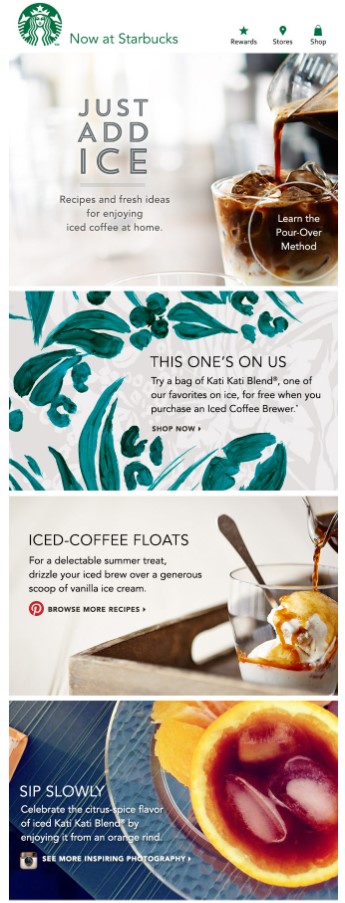
To make this more scannable, the brand paired these short descriptions with high-quality images (in the first image, you can practically hear the coffee being poured over ice). They also use clear, horizontal divides in order to separate each topic.
Besides, we really love the way they incorporate the Pinterest and Instagram logo alongside 2 CTAs. These logos support the text by setting the reader’s expectation up front. In other words, they understand that clicking through to browse more recipes will ultimately direct them to Pinterest or Instagram.
Read more: 11 Email Design Best Practices for Marketers
5. Lower your bounce rate by following best email hygiene practices
To keep your email bounce rate as low as possible, you must have a double opt-in method whenever someone signs up to your list. This will significantly reduce the chance of including incorrect addresses in your database.
Here’s how Sellfy sends out a verification email to confirm its subscriber’s email address:

In addition, you must build your email list organically and avoid buying lists at all costs.
Besides, if you notice dormant subscribers that have shown no engagement within 30 or 60 days, consider re-engaging them with a win-back email series, which targets to re-engage inactive subscribers.
You may have received such an email after abandoning your cart, like this one from Amazon:

If they still don’t engage with you, remove them from your list right away. Doing so will help significantly reduce your bounce rate.
Learn more: 11 Email Marketing List Management Practices & Tools
6. Reduce your unsubscribe rate by letting users set their preferences
Most people opt out of your list if they receive too many emails. Irrelevant emails are another factor contributing to the unsubscribe rate.
Focus on delivering relevant emails and let recipients set their preferences for receiving your emails. You can create a consistent schedule so that your recipients know when to expect an email from you. Or, you can even ask them right in your welcome email like this:

7. Convince subscribers to buy by delivering value through emails
Your email copy should be persuasive enough in order to convince your subscribers to buy from you.
Consider using the power of storytelling in your emails and tap on the emotional instinct of modern customers. Not only will this help you get better conversion rates, but it also yields more ROI.
The bottom line
You should be vigilant about the metrics you’re tracking, so that you can effectively measure your email campaign success and make necessary modifications if needed.
In order to recapitulate, you must strive to reach a larger audience, generate more useful emails, as well as think of innovative ideas to attract your subscribers. If you’re able to work on these three things, you’ll certainly yield better results from your email marketing campaigns.
New Posts






